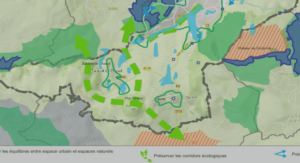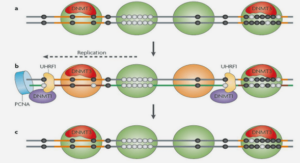Mechanical soil erosion is a natural phenomenon which became a problematic issue for farmers and rural communities since it has been accelerated, i.e. when natural rate has been significantly increased by human activities. Since the second World War, agricultural practices are responsible for a significant acceleration of erosion in Western Europe, due to large changes such as mechanisation, new agricultural policies and rising consumer demand. Most concerns about accelerated soil erosion are related to its negative effects, e.g. water pollution, lower crop yields, reduction of water storage capacity or organic matter losses (e.g. Andraski and Lowery, 1992; Berger et al., 2006; Boardman and Poesen, 2006; Papiernick et al., 2009). The protection of soil as a crucial natural resource is an important challenge, which requires an identification of the major soil erosion-deposition processes involved the assessment the spatial variability of erosion-deposition rates.
Recent soil redistributions observed in croplands of Western Europe were mainly attributed to water processes. Soil erosion by water requires the detachment of soil particles and their transport by runoff water. However, it has been recently outlined that tillage erosion appears to generate significant soil redistribution in intensively farmed cropland (e.g. Lindstrom et al., 1992; Govers et al., 1994; Boardman et Poesen, 2006; Cerdan et al., 2010). Tillage translocation corresponds to the displacement of soil during farming operations.
Soil erosion in agricultural hillslopes is controlled by numerous factors, especially soil properties (physical and chemical), erosivity of soil particle vectors (raindrop impact, runoff and tillage implements), hillslope morphology (slope, slope- and curvatures), landscape fragmentation and associated various landuses and managements (Morgan, 2005; Verheijen et al., 2009). However, these factors present different degrees and patterns of spatial variability from regional scale (climate) to in-field scale (soil surface properties, landuse and management). Their interactions through space induce that the predominant erosiondeposition processes, their intensities, and their variations could radically differ within a field, a hillslope, and from one hillslope to another. Quantifying soil erosion in agricultural landscapes, outlining its driving processes, and specifying its spatial varaibility, appears then to be particularly difficult.
In addition, data about middle-term soil redistribution are sparse for Western Europe. Research projects and Ph.D. works are predominantly contractual and limited to a few years. Therefore, experimental approaches of soil translocation with regular data recording in-field are time-restricted. Experiments do not allow appreciating the entire temporal and spatial variability of the erosion processes involved. Nowadays, study of soil erosion requires rapid and efficient techniques to characterize soil translocation in areas subject to accelerated erosion since the last few decades.
This paper reviews the dominant processes (water and tillage-induced processes) causing soil losses and gains in cultivated hillslopes of Western Europe, and the factors which control these processes. Two spatial approaches are considered, the local and the landscape scale, to highlight the influence of landscape fragmentation and various landuses and managements on soil erosion-deposition intensities and patterns. We then suggest a list of Soil Erosion-Depostion Indicators. These indicators are intended to qualify and/or quantify rapidly one or both of the dominant processes involved on soil redistribution in cultivated areas without any experimentation.
Soil erosion-deposition processes
Soil erosion-deposition at local-scale
Water processes
Soil material displacement by water has been widely studied on agricultural context. Its appearance requires two important phenomenons: the detachment of soil particles and their transport by water throughout the hillslope.
Detachment of soil particles
The detachment of soil particles requires first the destruction of soil aggregates, and consequently depends mainly on aggregate stability (Kemper and Rosenau, 1986; Farres, 1987). The main characteristics controlling aggregate stability are texture, organic matter content, clay-mineral composition, and the nature and content of cations and Fe-Al oxydes (Wischmeier and Mannering, 1968). However, the organic matter content appears to be the most influential parameter for soil-aggregate stability on cultivated temperate lands of western Europe (Monnier, 1965; Haynes and Swift, 1990).
Soil desaggregation by water occurs through different physical and physico-chemical mechanisms, which affect aggregates at different levels – from the micro-scale (clay particle) to the macro-scale. Four mechanisms of desaggregation have been identified (Le Bissonnais, 1996). Their relative intensity appears to be controlled by soil physical/chemical properties, and by the rain event nature:
– the slaking consists on aggregates break-down by compression of the entrapped air when aggregates are rapidly wetted (Panabokke and Quirk, 1957; Emerson, 1967) .
– the mechanical desaggregation under raindrop impact: aggregates are fragmented, and particles are eventually taked off from the surface of aggregates depending on the kinetic energy of the raindrops (Al-Durrah and Bradford, 1982; Nearing et al., 1987). The short-distance lateral displacement of the pre-detached particles that could occur then is called the splash effect (Ellison, 1945).
– the desaggregation by differential swelling corresponds to the cracking of aggregates because of an alternation of swelling/drying phases of the clayey particles (Kemper and Rosenau, 1986).
– the physico-chemical dispersion comes from the reduction of attraction strengthes between colloïds during swelling (Emerson, 1967).
Moreover, detachment of soil particles could occur through runoff flow traction, when flow shear stresses exceed aggregates shear strengthes. Detachment rate then depends on various parameters such as aggregate stability, aggregate size, flow shear stress or flow velocity (Nearing et al., 1991; Kuznetsov et al., 1998).
Transport of soil particles
The transport of soil particles requires the intervention of active agents, raindrop impact and runoff energy, which produce the next four processes: splash erosion, sheetwash, rill erosion and gully erosion. Among these transport processes, we dissociate nonconcentrated erosion processes (splash and sheetwash processes, i.e. interrill erosion) where raindrop energy is the principal agent of transport, and concentrated erosion processes (rill and gully erosions) where soil particles transport is predominantly induces by runoff energy (Bryan, 2000; Cerdan, 2001). The interrill processes occur intermittently on the whole hillslope area, whereas rill and gully erosions, which are linear processes, can be randomly or systematically distributed over the hillslope area.
Introduction |




